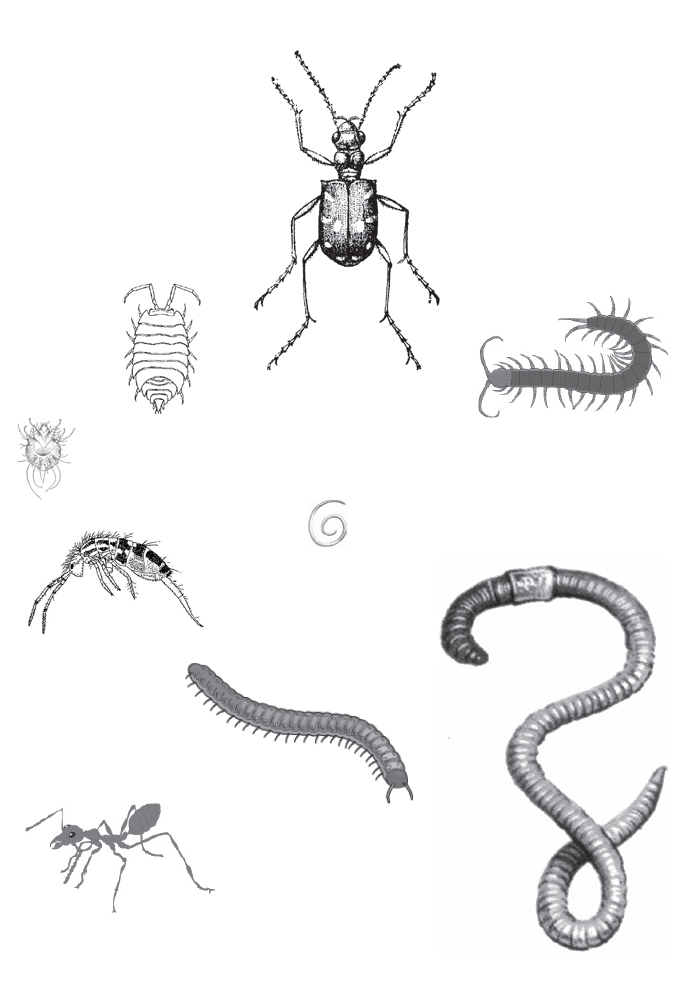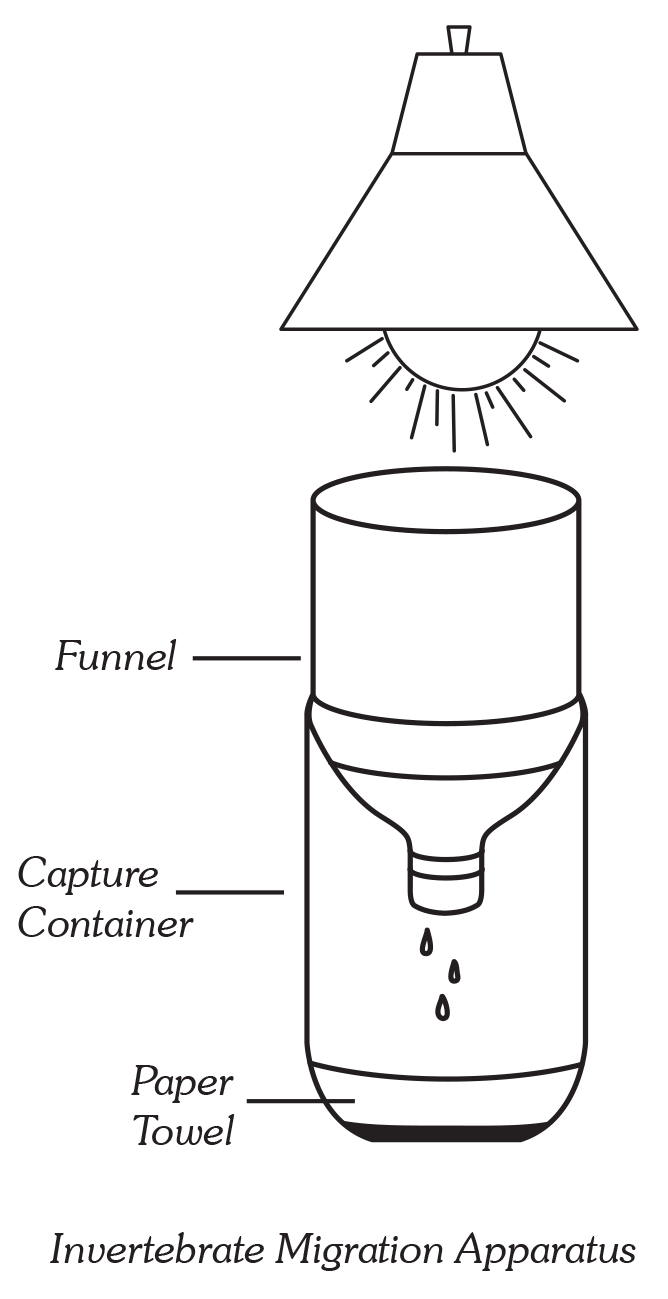 Relevancy and Engagement
dc.agclassroom.org
Relevancy and Engagement
dc.agclassroom.org
Secrets to Healthy Soils
Grade Level
Purpose
Students determine that the diversity of life in soil contributes to soil fertility. Grades 3-5
Estimated Time
Materials Needed
- Ziploc bags for collecting soil samples
- Soil sample from top layer of a soil high in organic matter, 1 per group
- Funnel and capture containers, 1 per group
- 1½" square piece of coarse screen, 1 per group
- Wet paper towels, 1 per group
- Light source with a shade (direct light)
- Hand lenses
- Soil nutrient testing kit (optional)
- Creatures in the Soil handout
Vocabulary
bacteria: a group of single-celled living things that cannot be seen without a microscope that reproduce rapidly and sometimes cause diseases
fungi: spore-producing organisms that lack chlorophyll and often grow filaments (tiny root-like structures)
invertebrate: an animal lacking a backbone (insects, arachnids, mollusks, etc.)
mutualism: mutually beneficial relationship between different kinds of organisms
mycorrhiza: mutualistic association of a fungus with the roots of a plant
nematodes: tiny roundworms that live in the soil
pathogen: a bacterium, virus, or other microorganism that can cause disease
protozoa: microscopic organisms with a nucleus that can be multi- or single-celled, animal- or plant-like, and are often motile
Background Agricultural Connections
Plants, animals, bacteria, and fungi all play an important role in soil development. Healthy soil is full of life! Plants provide a protective covering that prevents erosion by slowing water and promoting water infiltration. Plants are also a primary source of organic matter. Annual plants grow and die in a short period of time. Trees and shrubs drop their leaves in the fall. This plant material provides food to many soil organisms as it decays. Plants also release chemicals through their roots that provide food for microorgansims and accelerate the process of chemical weathering (breakdown of rocks, which releases nutrients and slowly turns rocks to soil).
 Multitudes of animals also contribute to the process of soil formation. Large animals contribute through their waste and the decomposition of their bodies after they die, while small mammals and many invertebrates live in the soil. Surface organic matter gets broken down and incorporated into the soil by the burrowing, eating, and mixing activities of voles, pill bugs, millipedes, mites, earthworms, and many others. Burrows and decayed organic matter improve and build soil structure.
Multitudes of animals also contribute to the process of soil formation. Large animals contribute through their waste and the decomposition of their bodies after they die, while small mammals and many invertebrates live in the soil. Surface organic matter gets broken down and incorporated into the soil by the burrowing, eating, and mixing activities of voles, pill bugs, millipedes, mites, earthworms, and many others. Burrows and decayed organic matter improve and build soil structure.
There are billions of organisms in a handful of soil, and 99.99% are microscopic decomposers that play the important role of recycling nutrients within the soil ecosystem. As nematodes, protozoa, bacteria, and countless other microorganisms (you’ll need a microscope to see these) attack organic matter in search of food, they release nutrients for uptake by plants. Fungi, which feed primarily on wood and leaf tissues, are particularly important; many types of plant material cannot decay without their initial action.
Lichens (pronounced like-ens), often the first life to grow on bare rock, make an interesting contribution to soil formation. Although they look like plants, lichens are actually a fungus and an alga living together in a mutualistic relationship (benefits both partners). The alga provides food through photosynthesis. The fungus provides the tiny, hairlike roots that hold the lichen in place, absorb water, and secrete chemicals into the rock to release nutrients. The chemical weathering performed by lichens begins the process of soil formation. As lichens die, organic matter accumulates. Debris brought by wind and water gets caught in the lichens. Eventually there is enough soil formed for mosses to grow and later ferns, grasses, and other herbaceous plants will follow. Lichens are interesting to look at close up with a hand lens.
Many relationships in the soil ecosystem are important to the crops farmers grow. For example, crops like corn and tomatoes form mutualistic relationships with fungi through their roots. The fungi extend the reach of the plants’ roots, providing greater access to water and nutrients, and the plants provide the fungi with energy produced through photosynthesis. This type of association is called a mycorrhiza (pronounced mike-uh-rise-uh; plural mycorrhizae, pronounced mike-uh-rise-ee). For another example, the roots of legumes like peas and soybeans can be colonized by bacteria that provide the plants with nitrogen from the air in the soil. Other relationships are not beneficial to plants. There are nematodes, fungi, and bacteria that damage and infect plant roots. Farmers want healthy soil that is full of life, but they don’t want the pathogenic (disease-causing) soil organisms. Luckily, soils full of beneficial organisms are often inhospitable to pathogens.
Engage
- Show your students some soil (a ziploc bag of soil, take them to a flower bed at the school, or show them a picture).
- Ask the students, "What is this?" Allow students to offer their answers.
- Once students identify the soil, ask them why soil is important. Allow students to offer their answers. Provide guiding questions to help students realize that soil is necessary to provide food to eat. The fruits, vegetables, and grains in our diet are grown in the soil. In addition, the animals that provide our meat, milk, and eggs eat food that was grown in the soil. With little exception, our entire food supply relies on soil.
- Continue with further questions such as:
- Is soil alive?
- What is soil made of?
- Do any animals or creatures find their home in soil?
- Inform your students that they are going to find the answers to some of these questions.
Explore and Explain
Activity 1: The Living Soil
Day 1
- Divide the class into four or five groups and provide each group with a Ziploc bag. Each group should designate someone to collect the soil sample or go on a walking trip around the school to make the collection.
- Note: Soil collected between late spring and early fall—not during winter—will work best. Take samples from the topsoil in an area high in organic matter; areas around compost piles or under logs are good candidates. Cultivated gardens or fields may not yield much diversity of life unless compost has been added and tilling has been limited. Students should record observations about the locations from which samples were collected. Keep soil samples moist until they’re used.
 Place the sample on a piece of white paper. Have students record their observations and note the number of different invertebrates they see.
Place the sample on a piece of white paper. Have students record their observations and note the number of different invertebrates they see.- Instruct the groups to assemble their funnels and capture containers. Each group should label the capture container with their names, place a wet paper towel in the bottom, and place the funnel on top (see the diagram).
- Next, each group should place the screen inside the funnel and fill it loosely with their soil sample.
- Place each assembled Invertebrate Migration Apparatus under a lamp. Make sure the lamp is 1/2" to 3/4" away from the soil. If it is too close, the soil will dry out too fast and cause some organisms to die. If it is too far, the organisms in the soil will not migrate to the container below.
- Turn on the light source, and leave it on overnight. Most soil dwellers do not like light, and they will try to dig deeper to escape the lamp.
Day 2
- The next day, turn off the light source, and collect the organisms that have been forced into the jar below the funnel. Observe the specimens with a magnifying glass and under a light microscope. Identify as many different types of creatures as you can.
- When finished, return all organisms and the soil to a suitable environment.
Activity 2: What nutrients are in my soil?
- Select the soil sample that had the greatest number and diversity of organisms and the sample that had the least.
- Ask students to predict which one will have the highest plant nutrient value. Perform a nutrient test on the two samples using one of the following options:
- Submit the soil sample to a lab. Every state has a University Extension service, most of which offer affordable soil testing. For more information on your state’s program, simply do an internet search for your state’s name and soil testing.
- Purchase a classroom soil testing kit from a science supply catalog and perform the tests in your classroom.
- Discuss the following questions:
- Based on the amount of soil life in your samples, can you predict the nutrient value? (yes, but not exactly; generally, the more organic matter, the more soil life, and the higher the nutrient value of the soil)
- Why are soil nutrients important? (plants and soil organisms need them to grow)
- Why are soil organisms important to farmers? (many reasons; they improve soil structure and the availability of nutrients)
Evaluate
After conducting these activities, review and summarize the following key concepts:
- Soil is an important natural resource.
- Farmers rely on healthy soil to provide the food we eat.
- Soils contain various forms of life including plants, animals, bacteria, and fungi.
Recommended Companion Resources
- A Handful of Dirt
- Dirt: Secrets in the Soil (DVD)
- Dirt: The Scoop on Soil
- Life in a Bucket of Soil
- Mountains of Jokes About Rocks, Minerals, and Soil
- Rocks and Soil
- Rooting for Plants: The Unstoppable Charles S. Parker, Black Botanist and Collector
- SOIL Reader
- Soil Health Education Resources
- Soil Science Society of America
- Soil! Get the Inside Scoop
- Soil, Not Dirt
- Topsoil Tour
- Under Your Feet: Soil, Sand and Everything Underground
- Up in the Garden and Down in the Dirt
- You Wouldn't Want to Live Without Dirt!